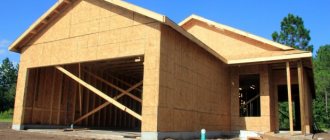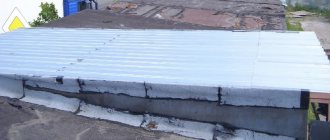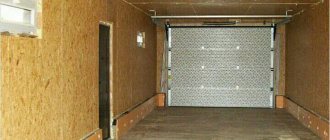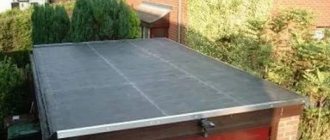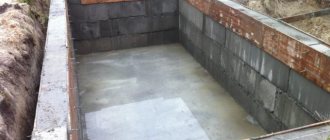Every car owner must ensure that his iron horse has a “home.” One possible option could be a reinforced concrete garage. This is a reliable and durable structure that will protect the car from any weather adversity. It is much more reliable than brick and iron. But previously, concrete structures had their drawbacks.
The construction of such a structure was expensive and labor-intensive, since all elements of the structure were manufactured on site. It was necessary to: pour the foundation, tie the reinforcement, set the formwork, fill everything with concrete and compact it thoroughly. And the cost of such a building was significantly higher than that of its analogues. And many simply couldn’t afford it.
Now the technology has become much simpler. Part of the structure is produced in factories and sold as prefabricated elements (based on the principle of a designer). This helped reduce costs by 50%. A concrete garage has become much more accessible and is gaining popularity among car owners. A prefabricated reinforced concrete garage is a construction kit for adult men that can be assembled without much difficulty, without the help of construction crews. The designers focused specifically on ease and simplicity of assembly.
Types of prefabricated garages
Today there are 2 types of reinforced concrete garages:
- Made. Its essence lies in the fact that all components - from walls to fasteners and gates - are included in the kit.
- Monolithic. A ready-made wooden box is purchased, into which the fittings are installed, and then the pouring process occurs.
The first type of garage is the most popular. It is simpler and cheaper.
Types of prefabricated projects:
- Garage prefabricated reinforced concrete products-1. The kit includes reinforced concrete slabs for mounting the structure, the linear size of which is 324/548/232 cm. The weight of the structure is 15 tons. In the photo you can see what reinforced concrete products-1 looks like.
- Prefabricated reinforced concrete products-2 with floor. Similar to the first one, but it includes a floor, so the weight of the garage is increased to 17 tons.
- Prefabricated reinforced concrete products-3 with floor and basement. Similar to reinforced concrete products-2, but requires additional blocks to build a basement. As a result, the total weight is increased to 26 tons.
Depending on your needs, you can choose the required type of garage and assemble it yourself or with the help of a construction team. It is not recommended to undertake the collection of reinforced concrete products-3 yourself, since the structure is more complex and dangerous to assemble.
Video on the topic
rmnt.ru, Igor Maksimov
The dream of every car enthusiast is a garage in which he can leave his car. But what should be the optimal size of a garage for 1 car? This question is faced by everyone who creates a garage project to make it a reality. You can resort to standard designs that are already designed for the optimal size of the garage. But only those who complete all the calculations and construction themselves will get real pleasure. Of course, you can resort to standard building dimensions. It all depends on the desire of the owner.
First of all, when drawing up a project, calculate the dimensions of the building. The most optimal garage size is a building measuring 3 by 6 meters. This is ideal for any type of vehicle, be it a car or even a jeep. Even a gazelle can fit into these dimensions. In addition to the car, there will also be shelves for tools and various drawers. If the area of the plot allows, then it is better to expand the garage by 1 meter. This width will allow you to store children's vehicles, such as bicycles and sleds, under the roof. And then the garage will become not only a home for the car, but will also become an excellent storage for many necessary things that should be kept out of reach of moisture.
Construction technology
The designers of such garages provide detailed instructions that clearly indicate the sequence of actions that must be followed. Let's consider the procedure based on the reinforced concrete products garage-2. Stages:
- Installation of floor slabs;
- Assembling the walls and rear wall of the garage;
- Installation of the gate panel;
- Installation of the floor panel (the panel is hollow);
- Roof installation.
Lifting devices will be required to install all components. Installing the gate will also require welding work. The advantage is that you no longer have to resort to welding work. The building slabs are fastened together using anchor bolts and brackets. Another advantage is that a garage of this type does not require interior or exterior finishing work. It is able to function immediately after assembly. Weather conditions will not have a detrimental effect on the strength of a reinforced concrete garage, unlike an iron one. The second requires painting to avoid metal corrosion.
But still, after a long period of time, the garage begins to wear out. The concrete will begin to crack, and particles of the reinforcing mesh will be visible in the cracks. In order to prevent the garage from further deteriorating, the fittings should be cleaned of rust (using a jet of water under pressure), coated with an anti-corrosion agent, and the cracks sealed with a special putty.
To save on heating costs, you can insulate your garage. Foam is most often used. It is attached to the outer walls of the garage using a special solution, additionally secured with plastic dowels. Afterwards, a plaster network is applied, which is embedded in the glue applied to the foam. At the end of the work, the surface is covered with putty and painted (optional).
We are engaged in construction
When the project for a garage for one car has been created, you can begin purchasing materials and construction. At the first stage, as always, there is a foundation. But before you start pouring it, you should decide whether there will be a basement or inspection hole under the building. Since construction is extremely easy, you can get by with a strip base.
A basement is an essential part of every home. And if it is not provided, then it is recommended to place it under the garage. The distance from the walls under the basement pit should not be less than 0.5 meters. It is necessary to strengthen the walls of the dug hole, provide entrance and ventilation. The latter is extremely necessary and should not be neglected, since the basement is an excellent place for moisture to accumulate, which can lead to the formation of fungus.
As it was said: since the weight of the building is small, the load on the foundation will be minimal. This means that a sufficient strip base is needed. It is necessary to mark the area using wedges and rope. Then dig a trench, install formwork, tie reinforcement, make a cushion of sand and crushed stone. And at the end of the work, fill it. After complete hardening, you can begin building walls.
If you are following a plan to build a home for a car, then you should know that it is recommended to make the floor concrete, since it will be subject to a constant load. It is also easier to remove various contaminants from such a floor, for example, machine oil, etc. The filling process is not complicated and is completed within one day. Since the size of a garage for 1 car is not too large, if you have a certain amount of money, you can resort to new technologies such as polymer floors. It is necessary to ensure a reliable descent to the basement and doors to it.
As for the walls and roof, it all depends on what material was chosen for construction. In principle, the process is no different from building a house. The only difference can be made when the decision is made to assemble a metal garage.
As for insulation, rarely does anyone use it for this building. Most often, the garage is equipped with a heating system that will maintain the optimal temperature. If the construction was made from blocks, then the building will still be warm. The only time insulation is extremely necessary is in metal structures.
When preparing the construction of any premises, you need to assess its volume, location and occupied space, and provide space for your needs. Same with the 1-car garage project. People often regret that they did not make it larger in the first place, because over time the room turns into a warehouse for old things, and there is not enough of it. And if a new or larger car appears, then this fact may force you to rebuild the garage.
Garage for 1 car
Why do you need to know the mass of a metal garage?
Information about the weight of a metal garage is required by owners in the following cases:
- There was a need to move the building to a new location.
To lift and transport it, you need to know the initial weight in order to correctly order loading equipment, the rental price of which varies greatly depending on the power. The situation is complicated by the fact that most of the buildings, dismantled or welded, are made by the owners themselves, and no preliminary calculation of their mass was made. In this case, you need to calculate the weight yourself.
- Construction is just planned; or buy a ready-made design.
You need to know the weight to order a vehicle with adequate power to deliver the cargo to the place. The foundation for a building is also poured to accommodate a certain load, and if done incorrectly, the reliability of the structure will be significantly reduced. Calculating the mass in such cases is not particularly difficult, since:
- companies that produce metal garages to order indicate the weight in the technical documentation for the project, which every buyer can access;
- In the case of self-assembly, determining the weight of building materials when purchasing is much easier than calculating the weight of a ready-made building.
Note! The standard size is considered to be a structure 3 meters wide and 6 meters long. The height of the walls is 2 meters, the total height of the structure is 2.6 meters.
Getting into GSK was not easy
The garage problem was solved through the organization of garage-building cooperatives. However, becoming a member to get a garage was difficult. To create a GSK, it was necessary to obtain permission from the district or city district executive committee. Local authorities approved the decision on the location of the garages, and this often took a long time. GSK participants had to pay a share.
Garage
There were also beneficiaries for whom an exception was made and they were allowed to install individual garages in the courtyards of their houses. These were honored front-line soldiers, disabled war veterans.
Having received a plot of land for indefinite use, GSK began to build a garage. Previously, GSK was required to deposit funds in the bank in the amount of the full cost of construction. It was possible to build only according to standard designs.
How to calculate weight yourself
Calculation of the final mass of a metal garage, the dimensions of which are 3x6 meters, is carried out according to the following algorithm:
- Calculate the area of the side walls. The area of one wall is 2*6=12 m2. We multiply the resulting value by 2 and get the total area of both walls - 24 m 2.
- Calculate the roof area. We take into account that the roof is gable, and its dimensions slightly exceed the dimensions of the building due to the canopies. The area of one slope is: 2 meters * 1.9 meters * 6.2 meters = 23.56 m 2. The area of two slopes is 47.12 m2.
- The area of the front wall, including the gate, and the rear wall is 12 m2.
- The gables that form the roof of the building have an area of 4 m2.
- Some garages have metal floors. In this case, its area is 18 m2.
- Now we know all the data, all that remains is to add them together: 4 + 12 + 18 + 24 + 47 = 105 m2.
Now it is necessary to determine the thickness of the metal with which the frame was lined. Most structures are made from sheets of metal, the thickness of which is 4 millimeters. One square meter of such cladding weighs 31.4 kilograms. Now we can calculate the total weight of the material used to cover the frame: 31.5 x 105 = 3,292 kilograms.
The frame of the structure, together with the gate, weighs about 1 ton. We add up the resulting numbers and get a final value of 4.3 tons. The values may vary up or down, depending on the thickness of the gate leaves and the material from which the frame was made.
We make an increase
Every inch of space is important in a garage. The aisles between the shelves and the car should not be too narrow. When walking back and forth, you can accidentally scratch the car. Four by six meters is the ideal size for a garage.
Many novice motorists are interested in how to calculate the size of a garage. The width of most cars is 1.8 meters, so if you decide to purchase even the largest vehicle, you can’t go wrong with the size. The material consumption will increase insignificantly from the meter added to the standard, and additional convenience is guaranteed.
One meter on each side is enough to easily get out of the car without staining your clothes or peeling off the paint on the door.
The average length of a car is 4.5 m. So 6 meters is enough to have access to the hood and trunk. But it’s better to make the height a little more than two meters.
What are the advantages and disadvantages of a precast concrete garage?
Advantages
The advantages of this type of garage made of concrete blocks, attractive to car owners, are as follows::
- Building a garage space does not take much time.
- A prefabricated garage is ordered as a one-piece kit with detailed instructions for constructing and strengthening the garage.
- If you decide to move, the structure can be disassembled and you can move it to a new location without any problems.
- No welding is required when installing reinforced concrete slabs into a single structure.
- Manufacturers present a number of options for such garages with a variety of individual parts and sizes of the garage itself, as well as its components.
- Prefabricated reinforced concrete garages are available for sale with a variety of garage space layout models. There are even options for possible openings-entrances to the cellar and options for installing a cavity for inspecting the car, varying in size.
What are the disadvantages of a prefabricated reinforced concrete garage?
- The components of the structure are very heavy; it will not be possible to handle it alone and without the appropriate technical equipment.
- Having built a garage according to the chosen project, you will not be able to modify it or remodel it in the future.
- High-quality delivery services for reinforced concrete tile material are not always provided. This creates a risk of their deformation, chipping and greatly complicates the assembly process and reduces their service life.
- The manufacturer may store the slabs incorrectly, this reduces their quality, which means the building will no longer be as durable.
Below you will see photos of reinforced concrete garages.
Choose a quality manufacturer that uses a proven delivery service.
Additional parameters and ergonomics
Comfort is especially important in a place where you may spend a lot of time. The car needs to be looked after and repaired. It is convenient to build a pit in a motorhome, but in this case it is necessary to think through electrical circuits, lamps and sockets.
The ceiling height for a normal feeling of space is a meter above your head; you can immediately mount an upper shelving unit. The shelves should accommodate not only tools, but also various household equipment. Space should be provided for spare and seasonal wheels. Ideally, you can place a small workshop in the garage. A workbench, a vice, one small machine or more will be very useful here. A small place to rest, a kettle with cups will not hurt if there is no living space nearby.
Garage doors need to be made 2 meters wider than the width of our car. It will be useful to think about the location of the lanterns inside the room; they will help you go there when it is already dark. Sockets should be conveniently located; provide in advance the required number for all needs.
Where would it be reasonable to put it?
- If you intend to set up a garage within the city limits in your house, cottage, or cottage, then a construction of this type in the basement of the building or where the basement is located will not oblige you to comply with the standards established at the legislative level, and you will not need to collect a bunch of permitting papers in different authorities.
- But if you decide to build a garage next to the house, then the reinforced concrete structure will be a serious structure and requires legalization of the building. It is possible to obtain such permission, but you will have to tinker.
On a private plot outside the city, you can easily install such a garage without unnecessary complications. But this will be justified if you live in the country for a long time.
Coming to a country house from time to time, such a design will be meaningless in terms of monetary investment and time spent on construction.
In this case, a prefabricated metal garage or even a very modestly priced tent garage would be more suitable.
- At the legislative level, there is a regulation that a ready-made garage of this type can be placed no less than a meter from the contours of the site and no less than ten meters from neighboring buildings.
- An attractive option is to install a garage under the cottage. This place will also save heating costs; in winter the ground itself will keep the temperature there above zero degrees.
The things you store in the garage will always be within easy reach. In fact, in addition to the car, you will place a utility unit directly in the house.
Gate width and height depending on vehicle type
Let's look at what gate sizes are optimal for different cars.
Passenger car
The height should be comfortable for even a tall person to pass, so it is correct to choose between 2 and 2.2 m. This figure is enough for a passenger car with a trunk to enter.
When calculating the width of a garage door, take the width of the car with side mirrors and add a tolerance. For a standard direct entrance, the tolerance is from 20 to 30 cm, when the entrance path is located at an angle - from 40 to 50 cm.
Crossover (jeep), minibus
An SUV, like a minibus, is always larger than a regular passenger car.
Therefore, the normal width will be 2.8 m. The height will be from 2.5 m to 3 m.
A striking example is the Toyota Land Cruiser model J200. Vehicle parameters (length, width, height) – 4.95*1.97*1.88 m. Suitable gate dimensions for such an SUV – 3*2.5 m.
Cargo (GAZelle)
The garage for a GAZelle truck is longer, which is due to the parameters of the vehicle itself.
If the length of the car is up to 8 m, then under the condition of direct entry, a width of 1 m will be sufficient; with corner turns, the figure will have to be increased to 1.5 m. For larger trucks, a larger design is created.
Truck and bus
It is not practical to build a permanent garage for such vehicles in a private house. It’s cheaper and easier to park your car.
Such buildings are used by industrial and agricultural enterprises to house KAMAZ vehicles, on-board vehicles, and trucks.
There are no restrictions on the width of garages in the Ministry of Emergency Situations, where several fire engines are parked at the same time.
The same applies to the trolleybus and bus depot.
What are the standard sizes of reinforced concrete slabs?
Let's consider the option - the components of a precast concrete garage kit are wall panels for the sides, one wall panel for the rear of the garage, two floor panels, panels for the basement, and a front panel for the gate opening.
- A garage of size 6000-3360-2200, using M200 reinforced concrete products, will be represented by right and left wall panels from a pair of slabs of size 6000-2200/2300-140.
- The rear part of the reinforced concrete garage is represented by a slab 3500-2200-140.
- Extension for gate 6200-2300-140, two reinforced concrete slabs.
- And three pieces of reinforced concrete for installing floors. Slab size 3500-2200-120.
We plan more accurately
To make the calculation of the future garage as accurate as possible, let’s pay attention to the following key factors:
- presence of shelves - are they necessary, or can you do without them;
— consider whether to install shelving on one side or on both sides;
— we remember that the width of a car rarely exceeds 2 meters, and we build on this fact;
— we think about the need to leave a passage on the right and left.
After analyzing everything, we will get the optimal dimensions, and then we will try to make an allowance for the future, slightly increasing the dimensions. One way or another, the decision will depend on the area of free land that we have.
Construction technology
According to the instructions, you need to assemble all the panels, securing them using the supplied components, these are brackets made of very durable metal, bolts, nuts, etc.
Before starting work, be sure to make sure that the manufacturer has packaged everything and sent it to you according to all items on the list attached to the product. Precast concrete garages are usually equipped with metal gates .
Foundation, pit/cellar construction
- There is no need for a special foundation; this is permissible due to the characteristics of the material.
- For the inspection pit, the prefabricated reinforced concrete garage is equipped with special reinforced concrete panels assembled according to the same type.
Since reinforced concrete structures tend to accumulate condensation, it is not worth making a cellar , as this will increase the already excessive humidity in the room.
- If you nevertheless decide to make a cellar, then you should seriously consider ventilation, interior lining, which reduces the level of humidity and it is advisable to heat the rooms for drying.
- If the garage does not have stable heating, then the inspection hole will also increase the humidity of the room; it is preferable to avoid creating an inspection cavity. Or use a thick awning or a special panel to cover it.
Roof
A lightweight single slab with voids in the body is used as a roof. You can sheathe and insulate it if you plan to have a heated garage. Otherwise, the lining makes no sense.
You can make a metal pitched roof superstructure to reduce the retention of precipitation on the surface, which increases condensation in the room.
Panel assembly
- Install the floor slabs first, then install the side walls.
- Proceed to installing the back plate connecting the right and left walls.
- Attach the front gate plate.
- The roof in the form of a separate slab is installed last.
If a basement is provided, then a queue is arranged first, at the very first stage.
Waterproofing
The floor and walls are completely waterproofed along the contour in the form of a strip of about 30 cm, starting from the very bottom of the walls. Waterproofing is applied by pouring concrete on the floor .
It is equally important to waterproof the ceiling using Hydrotex-U. Fiberglass is applied to more vulnerable areas and where the seams of the structure lie; it is sold in the form of tape and glued to a special compound.
Insulation
Foam sheets are the most common insulation for reinforced concrete buildings..
- It is glued directly to the walls using special glue.
- Then the entire surface is plastered, the plaster is applied to a thick and thick layer of glue distributed over the surface of the panels.
- Next, use putty.
- You can stop there, or you can cover it with paint.
Watch the video about insulating a garage with foam sheets:
A flat roof is finished on the outside with roofing felt material , or in the case of a pitched roof, ondulin or corrugated sheeting is used.
If desired, the roof can be insulated from the inside in the same way as the walls.
Heating
- A convector is a lightweight heating option; it will mainly affect your indoor comfort in cold weather and will serve to warm up your car in severe frosts.
- Warm floors can effectively dry a room, they are safe in terms of the possibility of fire, and they can be turned on for a long time.
- A radiator powered by an electric boiler is a good option that combines the advantages of the first two.
Finish options
- Siding is a very aesthetic and inexpensive option.
- Stone of artificial origin - such finishing, in addition to giving a beautiful look to your motorhome, will also increase the heat capacity of the room.
- Finishing with plaster will have a good effect on the level of humidity in the room, significantly reducing it.
- Lining is an excellent option, but very expensive. But it will create an additional bonus in terms of insulation and humidity parameters. It’s nice to be in such a room, if in addition to the garage it is also a utility block, then the lining will be optimal. It will be necessary to treat the wooden surface with solutions to prevent rotting and fire.
- Chipboards are a good eco-friendly option, increasing the heat capacity significantly.
A long-living garage, easy to install, and provided the room is insulated, can surpass even brick garages in its ability to retain heat. In terms of price, the construction will cost several times less than the brick version.
What can be added?
How can you use a garage other than to store your iron horse? The first idea that comes to mind is to equip your own small workshop for car repairs and other housework. Here you need to decide what you want to have in it.
If you make an inspection hole to inspect the car, the dimensions of the garage for 1 car will not change, except in depth. It’s another matter if you are going to install a homemade lift - here the width of the garage for one car will increase by a meter and a half and the height of the building will increase significantly, up to three or even four meters.
Size of a garage for one car - dimensions in the picture below:
As for equipping the workshop with shelving, cabinets and a workbench, take a tape measure, calculate their approximate area and add it to the area of the optimal garage from the example above. Don't forget about free space to access them too.
Let's say all your shelving takes up 2 m2, the workbench takes up the same amount, and other equipment and storage space for tools, materials and spare parts takes up 4 m2. In total it will be 8 m2.
Racks can be placed along the side walls of the garage, in which case two racks on the left and right with dimensions of 2x0.5 meters will add a whole meter to the width of the garage for one car. A workbench and other equipment with a total area of 6 m2 will require approximately the same amount of space for free maintenance.
As a result, we will need to equip 12 square meters of free space in the back of the garage. This will require adding at least 3 meters to the original length of the garage. We will equip our workshop with a lift to carry out repairs and maintenance of the underbody of the car with comfort.
Some car enthusiasts don’t stop there either, because an extension with a storage area or a rest room can be made to the car box. It is worth remembering that it is undesirable .
It is much more rational to place such extensions on one side of the building, or to make a second floor . And some of the things that are not used very often can always be put in a pre-made basement.
You don't have to stop at a workshop or break room. Show your imagination, go for it and make the garage of your dreams. We hope that our article helped you in this difficult matter.
The garage is the home for your car. It should be warm and definitely comfortable. Only in an atmosphere of complete comfort can high-quality repairs or maintenance be carried out. When planning the construction of a parking lot for a car, it is important to find out the standard dimensions of a garage for 1 car in advance. Based on these data, inspect and measure a suitable area, take into account your desires for arranging the interior layout. This is of particular importance when building a garage with your own hands.
High-quality and efficient work can only be achieved with strict planning and calculations. Often, the standard size of a garage for 1 car has a minimum size of 3x6 meters. Such a layout will most likely not allow you to place the necessary shelving and workbench in the finished room, and will also cause a lack of work space.
In this article we will try to figure out what the optimal size of a garage should be to ensure its comfortable operation.
Hint: will the premises be part of a residential building or adjacent to it? Typically, garages adjacent to the house or as part of the residential building itself have a common roof. This means that remodeling such a structure will not be an easy and costly task.
Basic drawings
When considering standard schemes, it is necessary to understand the advantages and disadvantages of each option.
The option on the left is only good if you just need to park two small cars. This is also a good option if you don’t have a lot of space for a garage. But you can’t store anything in such a garage, and it’s extremely difficult to move around in it. The disadvantage is that it will be extremely problematic to place a larger car together with a second car.
The option on the right is an option for a more prepared garage for working in it. The width on each side allows you to install small shelving or easily open doors without fear of scratching them. The length of the garage is enough for a very long car (up to 5 m), or to accommodate a workshop.
The width allows you, when replacing a car with a larger one, not to worry or think about the fact that it will be extremely cramped.
Combination options
If there is no utility block and bathhouse on the estate, then the functions of the garage can be expanded by providing space for these premises. This achieves savings in materials and working time and creates a compact functional area for men’s recreation and household work.
There are no particular difficulties in building a garage for 2 cars with a utility block. By expanding the box by only 2-2.5 meters, we will have space for a storage room, a pumping station, a mini-sauna or a bathroom with a shower. This last convenience is especially important if the garage is far from the house.
Another popular combination option is a house with a garage for 2 cars. If the soil conditions of the site allow, the autobox can be placed entirely in the basement. If the groundwater level is high, the best option is to add a garage to the house.
In this case, it is necessary to provide a doorway in the common wall and calculate the floor level in the extension so that the height difference between the house and the garage is minimal.
A garage roof is another structure that can be adapted for a variety of needs, from temporary living to storing household items. The materials for an attic roof will not be required much more than for the construction of a pitched roof. A spacious attic is a useful “bonus” that will cover all costs.
We recommend: Controversial issues regarding land plots
Regarding wall insulation, I would like to say the following. If you don’t need to do repair work in your garage in the winter, then don’t spend extra money on thermal insulation and heating. Entering a warm garage from cold air negatively affects the condition of the car (condensation falls in the internal cavities of the body, sharply activating corrosion processes). Long-term observations have shown that one year of storing a car in a warm box (with frequent visits) is equivalent to three years of keeping it in a cold garage. As they say, draw your own conclusions.
